"The BTU tax would increase the production cost and price of all goods and services."
Bill Clinton's economic program calls for some $295 billion in taxes over the next five years. To put this tax hike in perspective: the adminis-tration's tax proposal is about twice the size of President Bush's tax increase, which was enacted as part of the 1990 budget deal. Roughly one-quarter of the new tax revenues are to come from the introduction of a broad-based energy tax, by far the most controversial element of the economic package. The so-called "BTU tax" is a levy on the heat content of energy1 and would increase the production cost and price of all the goods and services produced in the country. The Treasury Department estimates that the tax would net roughly $22 billion per year by 1998, when it is fully phased in.
Arguments for a BTU Tax. Proponents of the energy tax point to several benefits. They argue that the tax would (1) significantly reduce the budget deficit and therefore lower interest rates and raise investment, (2) reduce America's dependence on foreign oil, (3) benefit the environment by encouraging energy conservation and (4) be fair and affordable for all income groups because the tax on low-income families would be offset by increases in low-income support programs.
Arguments against a BTU Tax. Opponents of the energy tax counter that it would (1) significantly harm the U.S. economy, (2) increase prices and the inflation rate, (3) impose financial hardship on low- and moderate-income families and 4) reduce the budget deficit by very little when all of its economic effects are taken into account.
[page]The debate on an energy tax is not new to Washington. For many policy analysts, it is the dream tax – a cure-all for some of America's vexing economic and environmental problems.2
- During the energy crisis of the 1970s, when energy prices were rising rapidly, proponents of the tax said that it was necessary to break the back of OPEC. (OPEC was eventually defeated through deregulation, not taxation).
- In the early 1980s when oil prices reached their peak of nearly $35 per barrel, many environmentalists said that the era of cheap and plentiful energy was forever ended and that a tax was essential to promote conservation. (Over the next ten years, without any new energy tax, energy prices hit their lowest real level in two decades, and reserves skyrocketed.)
- By the mid-1980s when energy prices were plummeting, energy tax proponents made a 180-degree turn, arguing that low energy prices were a curse, not a blessing, and urging the government to raise U.S. energy prices to European levels.
- In recent years, energy tax enthusiasts have maintained that such taxes would reduce pollution, reverse global warming, improve America's trade imbalance, raise the value of the dollar and reduce the deficit.3
"The energy tax has been touted as a panacea for almost every economic and ecological crisis."
In sum, over the past several decades the energy tax has been touted as a panacea for almost every economic and ecological crisis that has confronted the country. Even though the arguments for the energy tax have proved groundless, support for the concept has never waned. The Clinton administration has now combined virtually all of these arguments to promote its version of the energy tax.
[page]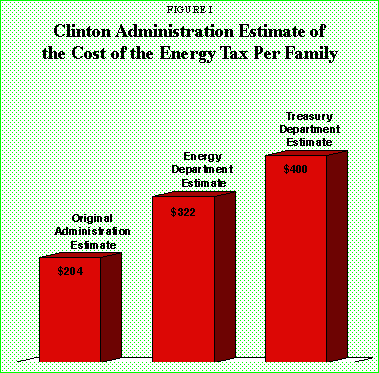
One of the main issues of contention over the energy tax is whether the burden would be spread fairly.
"Even the Treasury Department says the cost per family would be twice the adminis-tration's estimate."
The Burden for Middle-Income Families. Bill Clinton ran for president pledging not to raise taxes on the middle class. Although the energy tax clearly violates this campaign promise, during his State of the Union address President Clinton assured Americans that the energy tax would cost the typical middle-income family just $17 per month – or $204 per year. This estimate is highly suspect, however, because all other forecasts – including government forecasts – say that the burden on middle-income families would be much higher. [See Figure I.]
- Clinton's own Energy Department estimates the cost per family to be $322 annually – 50 percent higher than the White House estimate.4
- In May, Clinton's Treasury Department revised its estimate upward to nearly $400 per year.5
- The nonpartisan Tax Foundation places the per-family cost at roughly $450 annually – or more than twice as high as the White House alleges.6
- Former Carter administration Energy Secretary James Schlesinger calculates that the tax would cost the average American family up to $500 per year – 150 percent higher than the White House estimate.7
Even though the President's $17-a-month figure has been repeatedly discredited by independent energy analysts and administration economists, President Clinton and Treasury Secretary Lloyd Bentsen continue to use it.
Different Burdens for Different Regions of the Country. The actual impact on particular families would depend on where they live, how much energy they use in the home, what types of products they buy and how much driving they do. Contrary to the administration's claim that the energy tax hits all regions of the country equally, energy usage and production vary widely by state. Even if the tax applied to energy uniformly, the tax incidence would be much higher for residents of some states than others. The fact that different tax rates are applied to different types of energy makes the impact even less fair.8 For example, one particularly arbitrary feature of the tax is that oil (except for exempted home heating oil) would be taxed at more than twice the rate of other energy forms. Table I shows that burdens for families would vary widely across the country. For example:9
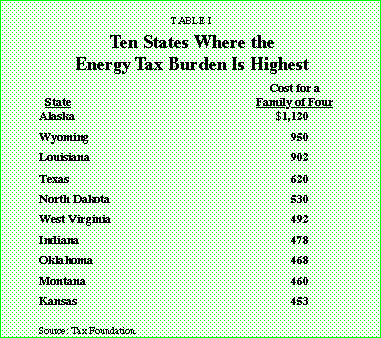
- A family of four living in Louisiana or Wyoming would pay more than $900 in new taxes.
- A family living in Alaska could expect to pay more than $1,100.
- By contrast, the cost for a family in Rhode Island would be only $213.
"The cost per family varies by a factor of almost six to one from state to state."
Higher Burdens for Low-Income Families. The Clinton administration argues that low-income families would not be made worse off because of the energy tax. The truth is that an energy tax is among the most regressive of all possible taxes. [See Figure II.] According to DRI/McGraw Hill:10
- Middle-income households spend about 9 percent of their income on energy-related items.
- Individuals in the lowest quintile in income spend 23 percent of their earnings on energy.
- The wealthiest fifth spend only 4 percent of their income on energy.
"An energy tax is among the most regressive of all taxes."
Still, President Clinton claims that no family with an income under $30,000 would pay more taxes because he also proposes to expand the Earned Income Tax Credit (EITC),11 food stamps and the Low-Income Home Energy Assistance Program. However, there are several errors in the administration's calculations:
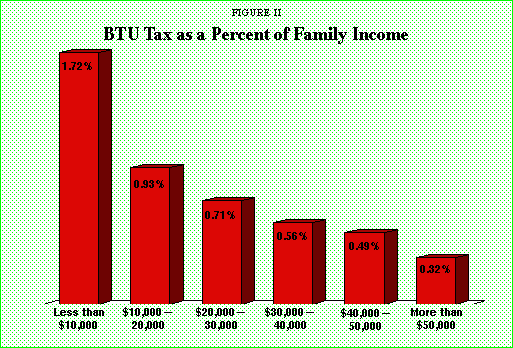
- In arguing that no family earning less than $30,000 would be worse off, the Clinton administration relies on an unusual method of calculating family income – one that includes fringe benefits, the imputed rental value of a home and other such sources of nonmonetary income.
- When normal taxable money income figures are used, it turns out that the average family with $25,000 of income per year would incur a net tax increase under the Clinton plan.12
- Although the EITC is the main offset to the energy tax for low-income earners, there are 18 million single, childless taxpayers who have incomes between $10,000 and $25,000 and who are ineligible for the EITC.13
- Although the administration proposes to increase government subsidies for low-income families by the average amount of the BTU tax they would pay, roughly half of the low-income families would have energy tax liabilities that are above the average.
Hence, for millions of poor families, a higher EITC and higher welfare benefits would not fully compensate for higher energy taxes.
[page]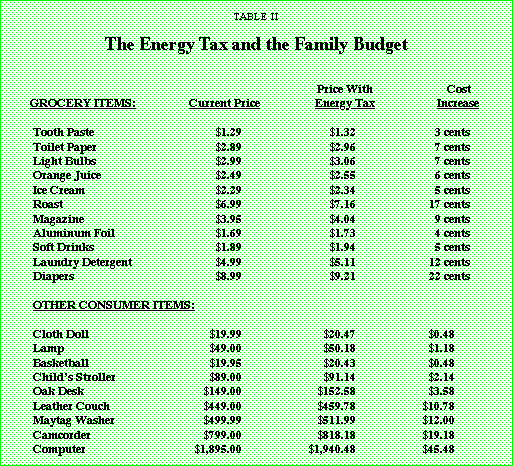
"Millions of poor families would be worse off because of the energy tax."
The Clinton energy tax is largely a hidden tax. That is, the tax would not show up as a separate item when goods were purchased. Rather, it would be embedded in the production cost of the goods and services we buy. This is quite deliberate. White House officials have admitted that one reason the administration opted for a BTU tax is that it is less conspicuous than a gas tax. And they have resisted, in some cases unsuccessfully, moving the tax collection point closer to the final consumer.
Although the energy tax may be hidden, its economic impact surely would be considerable. An energy tax entails a simultaneous double shock to American workers – through output and prices.14 And certain industries would be especially hard hit. The following analysis is a brief summary.
Lower Output of Goods and Services. The energy tax would raise production costs. Because there would be no corresponding rise in income levels, producers would find it impossible to pass on the total cost to consumers by simply raising prices. Thus some of the cost of the tax would be in reduced output and increased unemployment. This effect is discussed in greater detail below.
Higher Prices. Some of the increased cost of production would be paid directly by consumers through higher gas prices, heating costs and electric utility bills. Consumers would also pay indirectly for the energy tax at the supermarket, the drug store and the shopping mall. White House economic adviser Robert Rubin conceded as much when he said, "The notion is [that] this BTU tax would get passed on to consumers."15 How much would prices rise at the checkout counter as a result of the energy tax? A DRI/McGraw Hill study concludes that:16
- The average increase in the inflation rate resulting from the energy tax would be 0.5 percentage points.
- This is equivalent to an annual pay cut or loss of purchasing power of about $225 a year for a family with an income of $45,000.
For energy-intensive items, prices are expected to rise by substantially more than 0.5 percentage points:
- A 1993 survey by the National Association of Manufacturers found that U.S. manufacturers expect the BTU tax to raise production costs by 4.8 percent on average.17
- If we assume that only half of the cost increase is reflected in higher prices, then the price of energy-intensive manufactured products would rise by 2.4 percent.
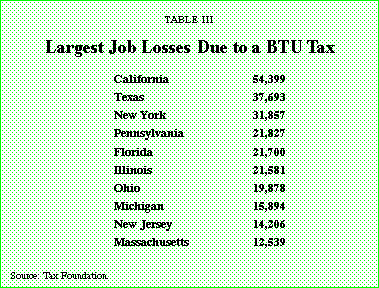
"The energy tax is roughly equal to an 8-to-10 cent per gallon increase in gasoline prices."
Effects on Family Budgets.18 Even though producers cannot pass on all of the cost of the BTU tax, consumers can expect across-the-board price increases. For direct energy purchases, the increased cost to consumers is fairly easy to calculate. The energy tax is roughly the equivalent to an 8-to-10-cent per gallon increase in gasoline prices at the pump.19 This would be the most dramatic increase in gas prices since the breakup of the OPEC oil cartel.
- The typical driver would pay roughly $1.20 more for each fill up (assuming 14 gallons purchased), courtesy of the energy tax.
- Adding in the $4.48 in state and federal gas taxes that drivers currently pay, on the average, the total tax on a tank of gas would be $5.68.
Edison Electric Institute estimates that the Clinton tax would mean a 3-to-4 percent increase in monthly electric bills, with especially heavy burdens in the colder climates of the North and East.20 Thus:
- The BTU tax would add roughly $27.60 per year to utility expenses of the average homeowner.
- The tax would cost New York, Pennsylvania and Ohio $1 billion per year each.
According to the Food Marketing Institute, the average family spends $80 per week on groceries. With the energy tax, the average family grocery bill would rise by almost $100 per year. Table II shows the impact on individual items.21
"The tax would add $100 a year to the average family's grocery bill."
Effects on American Competitiveness. The BTU tax could weaken the international competitiveness of major U.S. industries. Currently, low energy costs are a primary advantage for U.S. manufacturers competing with Japanese, Korean and European industries. Low energy costs help U.S. industry keep production costs low. Proponents of the energy tax contend that U.S. industry would not be hurt by the energy tax, because energy costs would still be lower in the United States than in competitor nations. However, unlike the Clinton proposal, Japan and most European nations exempt industrial fuel from their energy taxes.22
The administration recently conceded that the energy tax would place U.S. industry at a potential competitive disadvantage and proposed that foreign goods imported to the U.S. with at least a 2 percent energy content pay a new border tax. Its purpose is to impose roughly the same energy tax on imports as on U.S. products. However, because the tax on U.S. goods is not rebated at the border, the energy tax would raise the cost of U.S. exports of computers, pharmaceuticals, industrial equipment and other goods. Hence, the energy tax would almost certainly exacerbate America's trade deficit. The industries that would be especially hard-hit by the energy tax include transportation, utilities, agriculture, chemicals, steel, aluminum, paper and lumber.23
"The energy tax is expected to cost farmers $1 billion per year."
Effects on Farmers. One reason why consumers would see higher food prices from the BTU tax is that agriculture is one of America's most energy-intensive industries. Farmers are heavy users of gasoline, diesel and other fuels for operating tractors, trucks and other farm equipment; fertilizing and irrigating use energy; lighting and heating use electricity.24 The total Clinton energy tax is expected to cost American farmers roughly $1 billion per year.25 Small and medium-sized farms, which already operate with narrow profit margins, would face huge new tax liabilities under the BTU tax. According to the American Farm Bureau, if the energy tax is approved:26
- A 500-acre Illinois corn farmer would see costs rise by $670 per year.
- A 400-acre rice farmer in California would pay $996 in direct and indirect costs due to the BTU tax.
- A 2,100-acre Kansas crop farm would see costs leap upward by $1,513.
- An average-size greenhouse/nursery in New Jersey would pay $1,469 in BTU tax.
- A 1,300-acre cotton/wheat farm in Texas would face a new tax liability of $2,650.
Effects on the Auto Industry. Two industries that have faced especially difficult financial times in recent years are airlines and automobiles. The Clinton energy tax would almost entirely nullify the gains from their painful but necessary restructuring. Consider the effects on General Motors:27
- General Motors estimates that the Clinton energy tax plan would add $68 million in direct production costs to its U.S. operations.
- GM estimates the indirect costs to be an additional $270 to $340 million per year.
- Thus the energy tax would impose $300 to $400 million more in taxes and related costs on a firm that lost $1.5 billion in 1992.
Effects on the Airline Industry. For U.S. airlines the story is similar. At a time when Congress and the Clinton administration have appointed a blue-ribbon commission to address the industry's ills, an energy tax would certainly add to them.
- The energy tax would add $950 million to $1.2 billion to the costs of operating airlines.28
- In the past three years, this industry has lost $6 billion and more than 10,000 jobs, and two major U.S. airlines are in Chapter 11 bankruptcy.29
Airline travelers would also feel the impact. The average cost of jet fuel is expected to rise by 8 to 10 cents per gallon – or up to 15 percent. The Air Transport Association estimates that this would add 2.7 percent to the cost of the average flight.30 Assuming this cost is passed on to the consumer, the ticket price for a cross-country flight from New York to San Diego would rise by about $10 per passenger. This is in addition to a 10 percent ticket tax the traveler pays under current law. The total tax on the flight would rise to nearly $50 per passenger.
"The BTU tax would destroy about half a million jobs and reduce the GDP by up to $50 billion."
Effects on Jobs. As the auto and airline industries illustrate, the energy tax would impose substantial new costs on American manufacturers. For many industries, the BTU tax would almost certainly require layoffs as well as delays or cancellations of planned plant expansions and new hiring – and it would lower profits. Several studies that attempted to quantify the job loss and economic growth reduction from the BTU tax have arrived at remarkably similar estimates.
- The well-respected Institute for Research on the Economics of Taxation projects that Clinton's energy taxes alone would cost the economy 500,000 jobs and $50 billion in lost output when fully implemented.31
- The National Association of Manufacturers estimates a loss of $38 billion in output and 610,000 jobs by 1998.32
- The American Petroleum Institute finds that the BTU tax over five years would reduce total GDP by $170 billion and reduce employment by 1998 by 600,000 jobs. The GDP loss is the equivalent of a loss of about $1,500 per household through 1998.33
- The independent economic forecasters at DRI/McGraw Hill estimate a net loss of 400,000 jobs by 1998 from the energy tax.34
The consensus of all this research is that the BTU tax would destroy about half a million jobs and reduce the GDP by up to $50 billion. Just as the BTU tax burden would be higher in some states than in others, job losses would be greater in states with energy-intensive industries. The Tax Foundation estimates of the largest job losses are shown in Table III.35
[page]"Although thousands of jobs would be lost, the reduction in energy use would be very small."
Major environmental groups have launched an intense lobbying campaign in favor of the Clinton energy tax. The Sierra Club, the National Audubon Society, the Natural Resources Defense Council and others have pledged to fight for the BTU tax. In large part, they support it because they believe it would reduce U.S. energy consumption. Because the tax raises the price of energy, it certainly would reduce its use. Unfortunately, this decline in energy consumption would at least in part be a result of the United States' producing fewer goods and services. Moreover, the amount of energy conserved has been largely exaggerated.36
The Impact on Consumption Would Be Small. After its full implementation, the Clinton energy tax would have little impact on overall energy use. Total energy consumption is expected to fall by less than 2 percent from the tax.37 This reduction in energy use is minuscule compared to the economizing that naturally takes place in a market economy:38
- In 1950, 27 percent of U.S. Gross National Product was spent on energy.
- Today the figure is less than 20 percent.
- Today it takes 25 percent less energy to produce a dollar of real output than it did 20 years ago.
The Impact on Pollution Would Be Even Smaller. The other environmental benefits would also be few:39
- An analysis by the Environmental Protection Agency (EPA) found that not a single pollutant would be reduced by even 1 percent as a result of Clinton's energy tax.
- Vehicle emissions of hydrocarbons and carbon monoxide would fall by 0.25 percent.
- Industrial emissions of nitrogen oxides, which are a major cause of smog, would decline by just 0.8 percent.
"The tax might increase pollution and cause oil imports to go up."
The Tax Might Increase Rather than Reduce Pollution. Energy expert Philip Verlenger of the Institute for International Economics testified before Congress that because of concessions made to northeastern states, "The effect of the tax is to make the nation's cleanest coal (western coal) less competitive with dirtier eastern coal." He continued that this "would push electric utilities and industrial firms to use more eastern coal."40
The Tax Might Cause Oil Imports to Go Up, Not Down. The energy tax has been touted as a way to reduce overreliance on imported oil. In truth, its impact on energy imports would be negligible. According to the Affordable Energy Alliance, "Even the small promised savings of 350,000 barrels per day (a 3 percent reduction) may not occur. That is because, by raising costs for U.S. oil producers and refiners, the tax would encourage the closing of marginal U.S. oil wells and boost costs of domestically produced oil products. This would encourage imports to grow faster than projected."41
[page]
President Clinton has repeatedly maintained that Americans are willing to pay more taxes and make the necessary sacrifices to reduce the $300 billion budget deficit. Even if that is true, the energy tax, which he is touting as a $72 billion deficit reduction measure, would at best cut the deficit by a fraction of that. And it might not reduce the deficit at all. Here's why.42
- Start with $97 billion. This is the amount of gross revenue the administration estimates it would collect from the energy tax over the next five years.
- Subtract $25 billion. The Treasury Department concedes that roughly $25 billion of this revenue would be offset by static reductions in income and payroll taxes.43 This leaves $72 billion for deficit reduction.
- Subtract another $42 billion. The administration plans to increase welfare spending by roughly $42 billion per year as an offset to the new taxes that low-income families would have to pay. This leaves the administration with $30 billion in net deficit reduction. Hence, according to the administration's own analysis, the energy tax would raise $3.50 in taxes for every $1.00 it reduces the deficit.
- Subtract another $5 billion. The administration neglects to take into account the dynamic economic impact of the tax. Independent forecasters have concluded that the energy tax would reduce GDP by at least $140 billion over five years.44 This would reduce tax revenues by roughly $30 billion, $5 billion more than was estimated by the Treasury Department. This cuts the net deficit reduction estimate from $30 billion to $25 billion.
- Subtract another $15 billion. The BTU tax would raise the inflation rate by an estimated 0.5 percentage points. As a result, federal expenditures would rise because programs such as Social Security are indexed to inflation. Hence, the inflationary impact of the energy tax would raise federal entitlement spending by roughly $15 billion over five years.45
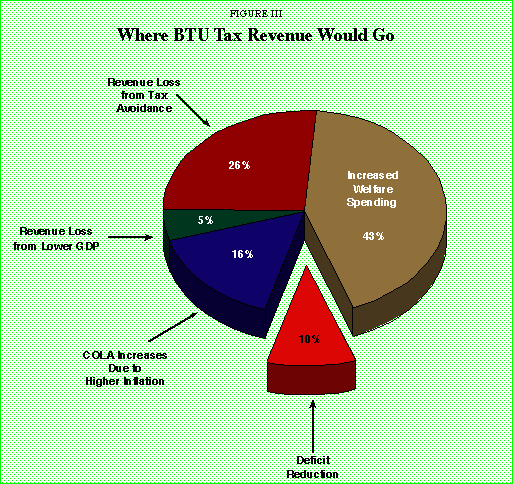
"What is touted as a $72 billion deficit reduction measure actually works out to no more than $10 billion."
As Table IV and Figure III show, the amount of deficit reduction is now down to $10 billion – or a scant $2 billion per year. Viewed from the perspective of deficit reduction, the BTU tax (combined with welfare spending offsets) is highly inefficient for two reasons:
- The BTU tax would raise $9.70 of revenue for every dollar that it (allegedly) would reduce the deficit.
- Since the BTU tax would reduce GDP by $35 billion per year in order to reduce the deficit by $2 billion, private output would decline by $17.50 for every dollar of net deficit reduction.

The reason that America has a budget deficit is not that taxes are too low but that federal spending has exploded. Between 1980 and 1990, federal tax receipts doubled from $517 billion to $1,031 billion.46 Next year, federal tax receipts would equal $1.2 trillion even without an energy tax increase. The typical American family already pays $16,100 a year in federal, state and local taxes, up from $6,970 per family (in 1990 dollars) in 1950.47 Since few families get $16,000 worth of government services each year, there is little reason to believe that Americans are undertaxed.
The energy tax is the largest single tax proposal in the Clinton economic program. If Clinton's entire $300 billion tax program were approved, it would be the largest tax increase ever passed by an industrialized country, increasing the tax burden in the U.S. to a level higher than it has ever been in peacetime. [See Figure I.] [page]
"The economic burdens the tax would create for millions of families are far greater than any possible benefits."
To reduce deficit spending, Congress needs to control spending, which have been growing at nearly 10 percent annually. When Bill Clinton announced his economic program, he said, "An energy tax is the best way to provide us with new revenues to lower the deficit."48 In truth, it may be the worst way. The administration could achieve the same amount of deficit reduction by simply cutting federal spending across the board 0.67 percent or, alternatively, by eliminating a single wasteful program, such as the Export-Import Bank, the Small Business Administration or the Rural Electrification Administration. Although the president claims that opponents of the energy tax are merely well-organized special interest groups, the fact is that the economic burdens the tax would create for millions of American families are far greater than any possible benefits.
Note: Nothing written here should be construed as necessarily reflecting the views of the National Center for Policy Analysis or as an attempt to aid or hinder the passage of any legislation.
[page]- A British Thermal Unit (BTU) is the amount of energy needed to raise the temperature of a pound of water by one degree Fahrenheit. For example, a gallon of gasoline contains about 125,000 BTUs. The Clinton administration originally proposed to tax most fuels at a rate of 25.7 cents per million BTUs with a 34.2 percent surtax added to oil, gasoline and diesel fuel. So-called "green" energy, such as electricity-making windmills and solar power, would be exempt. So-called "clean" energy, such as natural gas, hydroelectric power and nuclear power would be taxed at the lower, base rate. Dirty fuels such as coal also would be taxed at the base rate.
- These arguments are summarized in John A. Tatom, "The Case against the BTU Tax," Federal Reserve Bank of St. Louis, May 1993.
- Clinton used many of these arguments for the energy tax when he unveiled his economic plan in the State of the Union Address, February 17, 1993.
- Energy Secretary Hazel O'Leary, statement on NBC Today Show, February 22, 1993.
- Associated Press, May 14, 1993.
- Tax Foundation, "Proposed Energy Tax Hits States, Sectors Unevenly," April 22, 1993.
- Robert Hershey, "Energy Tax Impact Understated Up to 50%, Industry Officials Say," New York Times, February 22, 1993, p. A14.
- Original inequities have been compounded as a result of horse-trading in the U.S. House of Representatives, leading to "one of the most exemption-loaded … revenue raisers in history." Michael Wines, "Congress's Twists and Turns Reshape Bill on Energy Tax," New York Times, June 2, 1993.
- Tax Foundation, "Proposed Energy Tax Hits States, Sectors Unevenly."
- Joyce Yanchar and Susan Haltmaier, "The Pros and Cons of Alternative Energy Taxes," DRI/McGraw Hill U.S. Review, March 1993.
- The Earned Income Tax Credit is a cash payment by government to low-income working families.
- Chris Frenze, "Taxing the Rich?" Joint Economic Committee, Minority Report, March 9, 1993.
- Ibid. Many of these taxpayers are elderly.
- A third possibility is that the energy tax costs might be fully pushed onto consumers and absorbed by families, substantially reducing their savings. This would mean that any reduction in government borrowing would be offset dollar for dollar by reductions in personal savings. Hence, national savings would not be raised by the energy tax, thus nullifying the objective of levying the tax in the first place.
- Robert Rubin, speech before the National Association of Manufacturers, Washington, DC, April 1993.
- DRI/McGraw Hill, "Comparison of the Economic Impact of the Clinton Administration's BTU Tax and Alternatives," May 1993.
- National Association of Manufacturers, "Survey on Clinton Economic Program," May 1993.
- Much of the analysis in this section is derived from Stephen Moore, "Attention Shoppers: Energy Tax Means Prices Are Going Up, Up, Up," Joint Economic Committee, Minority Report, June 1993.
- Lawrence C. Kumins, "The BTU Tax Proposal," Congressional Research Service, Issue Brief, April 19, 1993.
- Edison Electric Institute, "President Clinton's BTU Energy Tax Proposal," February 23, 1993.
- Calculated at $1.92 per week. See Moore, "Attention Shoppers."
- House Ways and Means Committee, Minority Staff, "The Truth about the Clinton Energy Tax," April 1993.
- Affordable Energy Alliance, press release, May 5, 1993.
- House Ways and Means Committee, Minority Staff, "The Truth about the Clinton Energy Tax."
- American Farm Bureau Federation, press release, May 5, 1993.
- Ibid.
- U.S. Senate Republican Policy Committee, news release, "The Clinton Energy Tax Puts People Last," February 17, 1993.
- Air Transport Association estimate, February 1993.
- Thomas Hayes, "How Industries View Energy Tax," New York Times, February 26, 1993.
- "Energy Tax Strives to Be Fair, But Some Would Feel Picked On," Wall Street Journal, February 19, 1993.
- Institute for Research on the Economics of Taxation, "Clinton Energy Taxes: Much Damage, Little Gain," March 19, 1993. Substantial job losses would result from the increase in gasoline costs alone. A 10 cent-a-gallon tax increase, which is roughly equivalent to the Clinton proposal, leads to a $26 billion GNP loss and a 250,000 employment loss. See Norman Ture, Carlos Bonilla and Stephen Entin, "The Impact, Shifting and Incidence of an Increase in the Gasoline Excise Tax," Institute for Research on the Economics of Taxation, July 17, 1992.
- The National Association of Manufacturers' economic model predicts that by 1998 "output has been reduced by $38 billion relative to its current-law path. Among the components of GDP, the largest losses come in personal consumption expenditures and business fixed investment…. The cost in employment is considerable. By 1998, civilian employment is lower by 610,000 jobs. In sum, the BTU tax does considerable damage to the economy and is extremely inefficient at reducing the deficit." Jerry J. Jasinowski, President, National Association of Manufacturers, testimony before the U.S. Senate Committee on Energy and Natural Resources, February 24, 1993.
- American Petroleum Institute, "Why Broad-Based Energy Taxes Would Harm the U.S. Economy and American Consumers," 1993.
- DRI/McGraw Hill, "Comparison of the Economic Impact of the Clinton Administration's Proposed BTU Tax and Alternatives."
- Tax Foundation, "Proposed Energy Tax to Have Dramatic Impact on U.S. Employment," May 26, 1993.
- John Shanahan, "Taxing America's Energy and Vitality," Heritage Foundation Backgrounder, No. 943, May 1993.
- DRI/McGraw Hill, "Comparison of the Economic Impact of the Clinton Administration's Proposed BTU Tax and Alternatives."
- Michael Fumento, "What Would an Energy Tax Do?" Investor's Business Daily, March 5, 1993, p. 1A.
- Ibid.
- Philip Verlenger, testimony before the U.S. Senate Committee on Energy and Natural Resources, February 24, 1993.
- Affordable Energy Alliance.
- Several independent analyses have concluded that the Clinton administration has substantially overestimated the deficit reduction impact of the BTU tax. They include the Institute for Research on the Economics of Taxation, "Clinton Energy Tax Increases: Much Damage, Little Gain" B.G. Hickman, H.G. Huntington and J.L. Sweeney, Macroeconomic Impacts of Energy Shocks (Stanford, CA: Stanford University Press, 1987); Chris Frenze, "The BTU Tax: If It Moves, Tax It," Joint Economic Committee, Republican Staff, May 21, 1993; John A. Tatom, "The Case against the BTU Tax" Everson Hull and Lawrence Kumins, "Policy and Macroeconomic Effects of a BTU Tax," May 3, 1982; and American Petroleum Institute, "The Effect of the BTU Tax on Reducing the Deficit," 1993.
- Treasury calls this effect an income offset. The effect assumes that nominal GDP and the price level remain unaffected by the energy tax. See "The Administration's Modified BTU Tax Proposal," U.S. Treasury, April 8, 1993.
- DRI/McGraw Hill, "Comparison of the Economic Impact of the Clinton Administration's Proposed BTU Tax and Alternatives."
- Ibid.
- Budget of the United States Government, Fiscal Year 1994.
- Stephen Moore, "Government: America's Number One Growth Industry," Institute for Policy Innovation, 1993.
- State of the Union address.